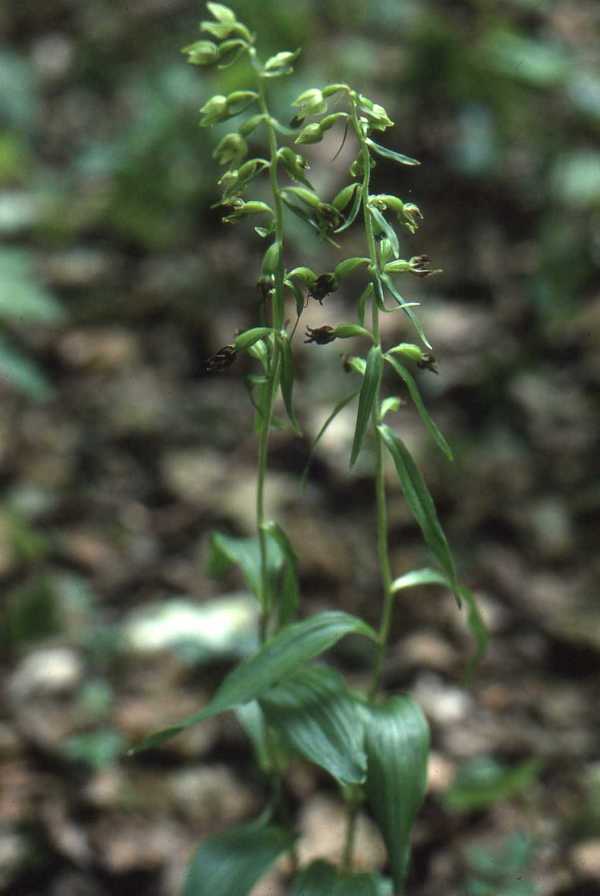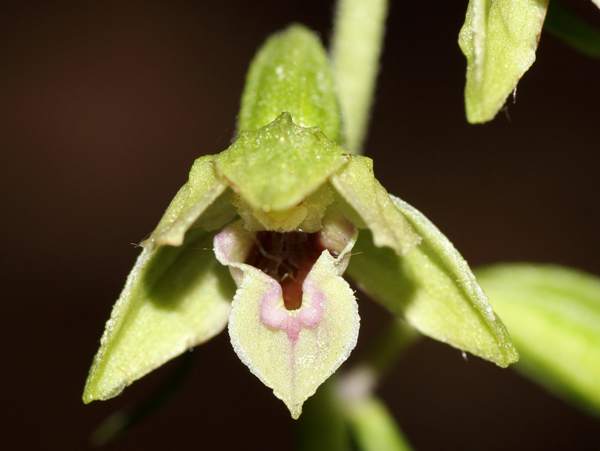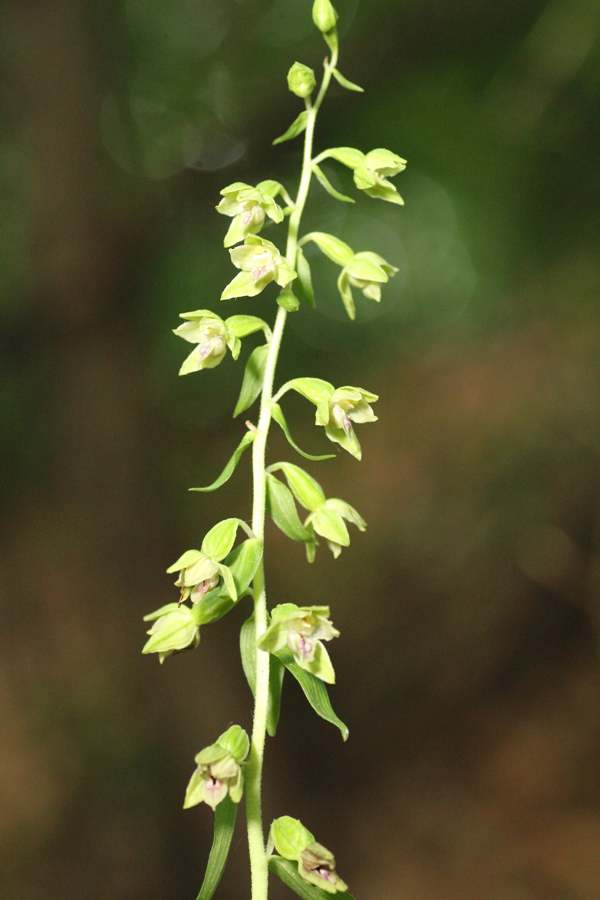Trees Birds Mammals Fish Amphibians Reptiles
Wild Algarve
Bookshop
Epipactis leptochila - Narrow-lipped Helleborine
Phylum: Magnoliophyta - Class: Liliopsida - Order: Orchidales - Family: Orchidaceae

Above: picture by kind permission of Anne Horsfall
Another member of the confusing Epipactis group of orchids, the Narrow-lipped Helleborine occurs in chalk-based woodlands in central and southern England. It has also been reported from Kenfig National Nature Reserve in South Wales.
Description
This orchid can grow to 75cm in height although a range between 40 - 60cm is more common. There are between 3 and 5 bright green leaves arranged in almost opposite pairs along the stem, and within the flowers there are further long, narrow bractlike leaves which are projected outwards and then sharply downwards.
The inflorescence is lax and can carry from 4 to 35 flowers, which are pale green. The flowers usually open fully and reveal a whitish lip that is sharply pointed at the tip and sets Epipactis leptochila apart from otherwise similar looking Epipactis species which have more rounded lips.

Distribution
Originally thought to be endemic to the British Isles Narrow-lipped Helleborine is now recorded from other European countries where its range extends from Denmark in the north to Italy in the south.
Habitat
This plant favours calcareous habitats and is very localised occurring on thin soils covering limestone rock. It is mainly associated with Beech trees but also occurs under coppiced Hazel. In Scotland they are associated with Alder and Birch. Like many orchid species Narrow-lipped Helleborine colonies vary considerably in numbers with relatively few appearing some years and then large colonies making an appearance in others.
Flowering times
This short-lived orchid flowers for around 10 days from mid-July to mid-August.
The specimens shown on this page were found at Creech Hill, near Purbeck in Dorset.

Varieties:
Epipactis leptochila var. cleistogama has been reported from Gloucestershire, but it may now be extinct.
Epipactis leptochila var. cordata is characterised by a shorter, heart-shaped lip, but this variety has also not been recorded for some years.
Etymology
The genus name Epipactis is an ancient Greek name of a plant said to be capable of curdling milk (perhaps a Hellebore). The type species of this genus is Epipactis helleborine, the species name of which means 'like a hellebore' - a reference to a physical resemblance in this instance. The specific epithet leptochila means 'with a slender lip'.
Reference sources
The Plant List
Sue Parker (2023) Wild Orchids of Wales - how, when and where to find them; First Nature e-book (Amazon Kindle format)
Anne and Simon Harrap (2005) Orchids of Britain and Ireland; A&C Black
Pierre Delforge (2005) Orchids of Europe, North Africa and the Middle East; A&C Black
Den Nordiska Floran (1992) Bo Mossberg, Stefan Ericsson and Lennart Stenberg; Wahlstrom & Widstrand
Pictures - centre and bottom: Elaine Hagget...
Sue Parker's latest ebook is a revised and enlarged edition of Wild Orchids in The Burren. Full details here...
Buy it for just £5.95 on Amazon...
Sue Parker's new ebook is a comprehensive and fully revised edition of her acclaimed field guide to the Wild Orchids of Wales. Full details here...
Buy it for just £5.95 on Amazon...
Sue Parker's 5-star acclaimed field guide to the Wild Orchids of the Algarve is now available as an ebook. Full details here...
Buy it for just £5.95 on Amazon...
Please Help Us: If you have found this information interesting and useful, please consider helping to keep First Nature online by making a small donation towards the web hosting and internet costs.
Any donations over and above the essential running costs will help support the conservation work of Plantlife, the Rivers Trust and charitable botanic gardens - as do author royalties and publisher proceeds from books by Pat and Sue.